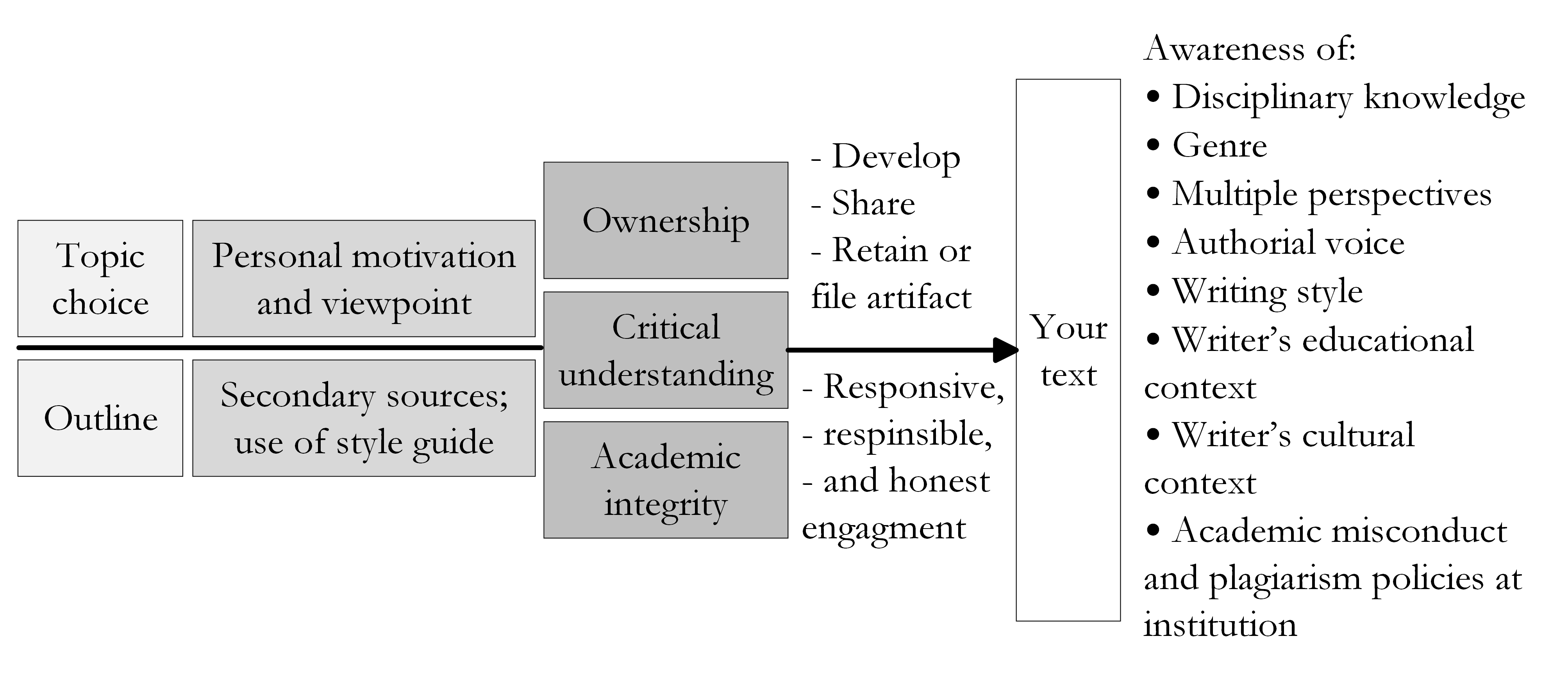Why Is Ownership Important for Academic Integrity?
The articulation of academic integrity as an opportunity for personal growth connects well with the idea of academic ownership. Typically, we own material objects (clothes, books, furniture, etc.) and sometimes we may share them with others or, once we have no use for them, we may give them away or have them recycled. Do you think learning works the same way? Do you write an assignment, share with others, and at some point, does the text lose its purpose? Does the text lose its currency after a period of time? If you answered yes, then perhaps, you noticed that course assignments are often shared for peer feedback or an instructor for comments and for grading purposes. Once the course has ended, the text becomes very similar to an artifact and a reference point for the writer.
The materiality of the text allows for it to be shared with others. In academia, such sharing or collaboration can be viewed as unauthorized if it impedes the quality of learning of another student. Therefore, text ownership is a valuable way to demonstrate what one has learned in publications, presentations, and even resumes to show experience. An author can maintain their ethical credibility by sharing insights, not the text itself, with another learner or using the same content for another learning venue (self-plagiarism) without instructor permission. The term ownership is, therefore, tied to the author as well as educational contexts and cultures of learning. Texts on a common topic can be spoken, read, and written differently depending on the location, purpose, and experience of a writer. Therefore, for an international student entering a post-secondary institution in Canada, writing an essay involves developing familiarity with the writing style and academic conventions. This does not imply that the student must completely change their competent use of language structures, but engage with a new set of teaching and learning expectations. Hence, ownership is formed by a series of decisions that we make to develop, share, retain, or file away the textual artifact. The writing process (Figure 1a) can be situated more elaborately by highlighting the role of textual ownership and academic integrity.

Figure 1b. The writing process
Thus, to answer the question that this section has posed, ownership is important for academic integrity because it can help writers personalize the information and identify common ground with discussions in the field as represented in Figure 1b. Instead of just collating data with in-text citations, texts are readable as a result of an improved understanding of genre expectations (for example, summary versus analysis), recognition of multiple point of views, and audience awareness. As well, being critically aware of one’s educational background and a socio-cultural perspective on becoming part of academic institutions can impact decisions on writing style and how an argument should be positioned in a text. In this approach, including citations and using language of attribution are not mechanical chores, but a decisive way to show one’s involvement and well-developed understanding of a topic. To exemplify, Strategy 1: Structure, outline, and first draft of an argumentative introduction showed the move from a writing template to a first draft of an introductory paragraph. As evidenced below, the first draft can be further improved by using ownership as a writing strategy.
Strategy 3
Second draft of the introduction
| (1) As soon as I open a website these days, I am bamboozled by remarkable jewelry sets that claim to be of high quality, but available with big discounts. (2) Undoubtedly, my last virtual browsing of Pandora’s latest charm collection has been analyzed by computer algorithms. (3) Professors of Computer Science, Talia, Trunfino, and Marozzo (2015) note that “big data analytics and knowledge discovery techniques” inform business practices (p. xi). (4) As a result, one can assume that shopping online will mean that an individual’s preference for product type, price range, and quantity is tracked to prompt all connected platforms to extract knowledge from this data set and advertise similar merchandise. (5) It is ironic that when one wants to purchase a new product, they base their choice on information received from news media. (6) In fact, all consumers decide to switch brands or buy new products based on ad campaigns on the internet and other programs on TV channels. (7) The process of data mining can envelope our choices by pushing information, even misinformation, which can overwhelm a buyer. (8) Given the increased discussion on fake news, it is important for all consumers to be on guard. (9) Before buying, they should investigate a manufacturer’s credibility and check the ingredients used in a product. | Personal connect (1)
Critical understanding of issue (1, 2) Disciplinary/interdisciplinary engagement (3) Academic style (3) Idea development based on author’s lived experience (4-7)
Thesis presentation as responsible engagement (8, 9) |
Activity 1
Compare the first (Strategy 1) and second draft (Strategy 3) of the introductory paragraph and jot down three ways in which the text has changed. As a reader, consider the follow-up questions:
- What do you think is the writer’s point of view or position on the issue?
- What is the purpose behind including a secondary source?
- What do you think the writer will discuss next?
Media Attributions
- Figure 1 © Anita Chaudhuri is licensed under a CC BY-NC-ND (Attribution NonCommercial NoDerivatives) license

